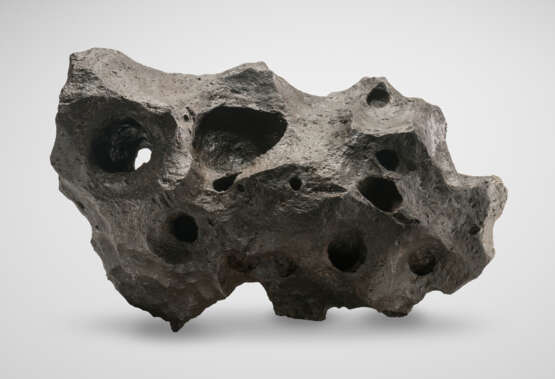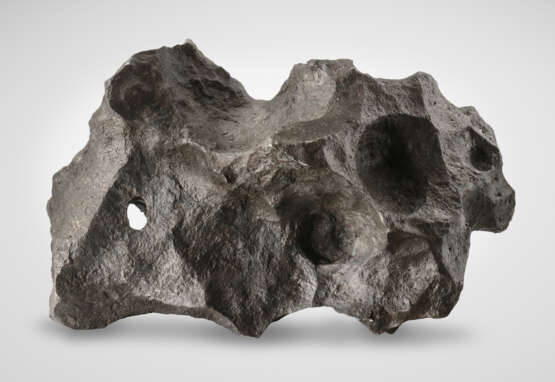ID 1279144
Лот 2 | A MATCHLESS CANYON DIABLO METEORITE
Оценочная стоимость
$ 100 000 – 150 000
Iron — Coarse octahedrite IAB-MG Meteor Crater, Coconino County, Arizona (35°3' N, 111°2' W)
A smooth metallic surface delimits the ellipsoidal metallic abstract form. Numerous sockets and perforations abound, the reverse side showing a face of cleavage along the natural crystalline plane of the meteorite. Wrapped in a gunmetal patina with both ochre and platinum-hued accents.
One of the most aesthetic iron meteorites known -- natural sculpture from outer space.
Like all iron meteorites, the current lot is more than four billion years old and originated in the asteroid belt between Mars and Jupiter. Evocative of a Henry Moore, this sculptural form was once part of the molten iron core of an asteroid that broke apart, a portion of which was deflected into an Earth-intersecting orbit. Approximately 49,000 years ago it crashed into the Arizona desert with the force of more than 100 atomic bombs. Fragments were ejected more than 11 miles away from the point of impact and the main mass vaporized, creating the most famous and best-preserved meteorite crater in the world—the renowned Meteor Crater near Winslow, Arizona nearly one mile across and 600 feet deep. The fragments of iron that survived the impact are referred to as Canyon Diablos (“Canyon of the Devil”), and they are the quintessential American meteorite prized by museums and private collectors.
The Canyon of the Devil became precisely that for one Daniel M. Barringer (1860-1929). At the turn of the 20th Century, Barringer reasoned that the crater had to be created by an enormous extraterrestrial mass weighing millions of tons. He believed this mass, worth a fortune in nickel and iron, lay under the crater’s base. In 1903 Barringer filed a mining claim and commenced a drilling operation that went on for years. Unfortunately for Barringer, scientists later determined that a mass much smaller than that which Barringer believed existed would have possessed sufficient energy to blow the huge hole in the desert floor—and would also have generated enough heat to vaporize much of itself. In effect, what Barringer spent the last decades of his life looking for didn’t exist. The Barringer Family maintains the crater and adjacent museum today in what is a major international tourist attraction.
Canyon Diablos are noted for containing nodules of graphite and carbonados (minute black diamonds). In the present specimen, it was the ejection of the graphite inclusions that resulted in the sculpting of sockets or hollows in close proximity on the mass. In a process referred to as terrestrialization, these sockets expanded in size when exposed to Earth’s elements as the seasons turned over the millenia. Some of these hollows expanded sufficiently to entirely penetrate the mass resulting in the sought-after rarity of a naturally formed hole. This meteorite has seven such complete holes, perhaps the most of any single iron meteorite.
31.2kg. (68 ¾lbs)
13 ½ x 8 x 7 ¼ in. (34.4 x 20.3 x 18.4 cm.)
Provenance
Robert Ward Meteorites, Prescott, Arizona.
Macovich Collection of Meteorites, New York City.
Christie's New York, 7-14 February 2018, lot 41.
| Категория: | Метеорит |
|---|---|
| Категория аукционного дома: | Окаменелости и минералы |
| Категория: | Метеорит |
|---|---|
| Категория аукционного дома: | Окаменелости и минералы |
| Адрес торгов |
CHRISTIE'S 8 King Street, St. James's SW1Y 6QT London Великобритания | |
|---|---|---|
| Предосмотр |
| |
| Телефон | +44 (0)20 7839 9060 | |
| Комиссия | see on Website | |
| Условия использования | Условия использования |




